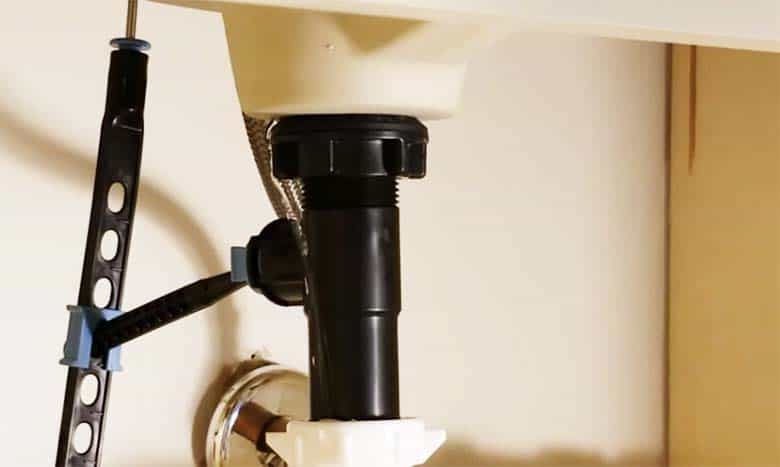When remodeling your bathroom or installing the new sink plumbing, you should keep a few important facts in mind. One such crucial consideration is the alignment of the P-trap and the sink drain pipe to ensure appropriate drainage in your bathroom. The bathroom sink drain pipe should align with the inlet of the main drain and basin’s outlet appropriately.
However, at times, the bathroom sink drain pipe and p-trap don’t meet, which makes the entire setup pretty useless. Thankfully, you can fix it with an adjustable pipe wrench. Also, this DIY plumbing project isn’t as complex as you would think.
When the P-trap and drain pipe don’t meet underneath the bathroom sink, there’re multiple ways to align them perfectly. You can adjust the pipe length horizontally and vertically or apply pipe extension for both the P-trap and drain pipe to fix the misalignment issue.
If you have the same issue in your bathroom only to see a malfunctioning bathroom sink and improper drainage, read this step-by-step guideline to fix it ASAP. Also, you will learn the reasons for the P-trap and drain sink not meeting properly. It will help you eliminate the reasons faster.
What Size Drain Pipe For Bathroom Sink Is Required?

In many cases, an improperly functioning bathroom sink happens due to the wrong size selection of the drain pipe. So, when you redo the bathroom sink, you must know the right size to select for the sink to ensure proper drainage and installation.
Also, note that the size of the drain pipe refers to its opening diameter, not the length. The standard size for the drain pipe is 1-1/4 inches. However, a few bathroom sink drain holes might accommodate even 1-1/2 inches and 1-5/8 inches drain holes for the pipe installation.
Next, look at how far should the drain pipe is from the sink. Although the distance of the P-trap and sink drain varies slightly, it should be less than 24 inches. If it exceeds 24 inches limit, you will have a hard time installing and aligning it.
So, before you get the drain pipe for the bathroom sink, measure its drain hole’s diameter properly and buy the drain pipe accordingly. It will make your DIY bathroom vanity installation easy.
Reasons for Bathroom Sink Drain Pipe and P-Trap Not Meeting
Multiple reasons can attribute to the wrong alignment of the P-trap and the sink drain pipe. You need to know them to install the bathroom vanity appropriately. It will make your DIY bathroom plumbing convenient too.
Reason 1: Wrong size drain pipe and P-trap
We have already mentioned that the P-trap and drain pipe size should match each other for a perfect installation. Unfortunately, most people will choose the wrong size drain pipe and P-trap only to see that they don’t meet each other.
It happens as many of the DIY plumbers will only use the previous measurement without considering the new setup in the bathroom. The distance between the P-trap and drain pipe should be less than 24 inches. Also, the drain pipe diameter must meet the sinkhole diameter properly.
Reason 2: The p-trap is located too far from the drainage space
If you install the bathroom sink too far from the drainage system, the chances are high that the P-trap and drain pipe will not meet properly. Also, it happens in older bathrooms where plumbers would put the drainage far from the P-trap.
Whatever may be the reason, the increased distance also boosts the chance of a leaky P-trap and drain sink connection. When it happens, you might see the bathroom sink drain leaking around threads and the P-trap connecting point.
So, how close to the drain does the p-trap need to be?
As mentioned in the previous section, the maximum distance between the P-trap and the sink drain mustn’t be more than 24 inches. There is a trap arm with the system. It connects the p-trap and vent drain in the bathroom vanity. Ideally, the slope of the trap arm should be ¼ inches for 1 feet distance.
Reason 3: Improper installation of the drain pipe and P-trap
DIY plumbers might install the drain pipe and P-trap inaccurately in many cases. They might assemble the wrong part during the installation process. Also, the alignment can go wrong, which will result in the P-trap not meeting the sink drain and causing water flow on the floor.
The wrong alignment happens when you place the P-trap at an inappropriate height from the sink drain. So, it brings us to an important consideration.
Can a p-trap be higher than the drain pipe?
The P-trap should be at less height than your drain pipe. When the P-trap is located at a higher place, it will need water force for the proper flow, whereas water should flow through it naturally. So, placing the P-trap too higher from the drain pipe can affect the drainage system dramatically.
Moreover, ensure that the P-trap isn’t placed underneath the main exit drain as gravity forces the water outward. It, too, results in slow and inaccurate drainage. Also, it will create another P-trap within the plumbing system and it is unnecessary.
How To Fix When Bathroom Sink Drain Pipe And P-Trap Don’t Meet
When the P-trap isn’t aligned with the bathroom sink drain, you can really use it. Thus, it can be frustrating to see the sink drain not working after a hard-fought installation process. Thus, it’s not a good scene, and you should fix it ASAP.
Also, it is important to ensure proper drainage running through the sink drain to the main exit drain to keep your bathroom and shower in dry and good condition.
Thankfully, the fixing process of the P-trap and sink drain pipe misalignment takes only a few minutes. Also, it doesn’t require any high-end plumbing skills either.
Things you will need:
- An adjustable pipe wrench
- A flexible drain pipe
The steps follow as:
Step 1: Remove and inspect the p-trap
In most cases, when the P-trap doesn’t meet the drain sink pipe or other installation processes, the main reason could be its wrong size selection. So, you need to remove the P-trap and inspect its size. For this, remove the collar of the p-trap with the wrench. As you loosen the locking collar, you can start turning the P-trap and remove it with ease.
You now need to look at its size following our suggestions on the above parts of this discussion. If you have selected the wrong P-trap size, you need to get the right one from a plumbing or hardware store and reinstall it.
Step 2: Readjust the P-trap and drain sink pipe
If you find its size appropriate during the P-trap size inspection, the misalignment has happened due to improper installation. Thus, you will need to readjust the sink drain pipe with the P-trap either vertically or horizontally.
So, when connecting the p-trap to the drain pipe again, ensure that you have selected the right height and length for it. First, start by placing the sink higher as you move the P-trap extension up and down to fit into the sinkhole appropriately. Also, if the pipe is too lengthy, you can cut and reinstall it.
Once you have adjusted their height and length, you can lock the P-trap collar to fasten and secure it against the drain sink.
Step 3: Use of a flexible drain pipe
In most cases, the sink drain pipe should meet the p-trap when you accomplish “Step 2.” If you still find issues, you need to fix them with the flexible drain pipe. To get the right model, consider the following points:
- Length of the p-trap
- Cap measurement
- Drain sink hole size
When you get the right flexible drain pipe model, you can attach it with the p-trap and drain sink. You need to follow the installation instructions on the flexible drain pipe kit for this. As you fasten the setup, run water to see that the drain pipe and p-trap meet properly and water is draining from the bathroom sink.
Cost of Fixing Bathroom Sink Drain Issue
A bathroom vanity adds functionality to your bathroom setup with the sink drain. However, when you see problems with it, such as its height not matching the P-trap, you should fix it ASAP. Although the fixing system is easy and quick, you might sometimes feel not doing the project on your own.
So, you will need to hire a plumber and count the cost of the required parts. It includes a flexible drain pipe mostly. The average cost will be:
- The flexible drain pipe will cost around $20.
- A professional plumber will charge $50 for 1-hour of consultation.
Therefore, you can expect to fix the sink drain and P-trap for around $100. However, if you need to fix other issues such as leakage in the drain sink, the cost can easily increase from $150 to $250. We recommend you fix it with a DIY project since these small fixations don’t need high-end plumbing skills at all.
Frequently Asked Questions
1. Is a P-trap necessary for the bathroom sink?
Yes, a P-trap is essential for both the bathroom and kitchen sink. It helps trap sewer gas to prevent the funny odor from spreading in your home. So, it keeps the home ambiance in good condition. Thus, you get rid of the foul odor and toxic gasses that might cause sickness.
2. Can a sink drain be offset?
Yes, a sink drain can be offset. These sink drains are located underneath the sink faucet or at the edge. On the contrary, the traditional drain is placed in the middle of the sink. You can opt for their specific installation technique for the offset sink drain.
3. Can a bathroom sink drain go down straightly?
Although technically, a sink drain can go down straightly, it’s not recommended in practical life. If the sink drain is installed straight, it will fail to trap the sewer gas, and the gas will slowly spread in your home. So, it’s a big no to install the sink drain straight.
Final Words
When the bathroom sink drain pipe and p-trap don’t meet, you don’t need to get panicked at all. It will only take a few minutes to fix it and align the P-trap and sink drain perfectly. Also, you can match them without any prior plumbing skills. So, you will appreciate the DIY project for sure.
I am James Martin, An professional plumber with more than 16 years of experience. The main purpose of my writing is to share my experiences of helping others. Be with me and explore bathroom plumbing, installation, cleanness ideas, and many more.





Pingback: Basement Shower Drain Leaking: [Reasons and Solutions]
Pingback: Can You Use 1 1/2 Pipe For Shower Drain? (Explained)
Pingback: Bathroom Sink Won't Drain Not Clogged: Causes and Fixing Process
Pingback: Water Heater Drain Valve Stuck: [Reasons and Solutions]